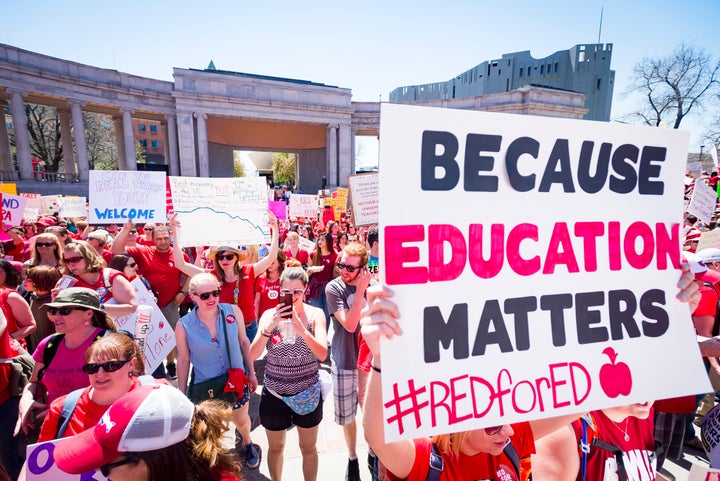
The widespread teacher protests that swept through states like Kentucky and West Virginia this spring have given way to an unprecedented wave of educators pursuing political office in November’s elections, the nation’s largest teachers union said in a memo released this week.
Nearly 1,500 current or former teachers and other education professionals are running for elected offices across the country, the National Education Association said in the memo. That updated an analysis from September, when the NEA said more than 500 teachers and educators had decided to run for office. The new number is a record for the number of educators seeking office in a single election cycle, the union said.
The new figure includes at least 1,455 teachers and educators who are seeking state legislative seats, and counts current and former teachers from K-12 and higher education, as well as administrative and support staff. More than 1,000 of them are running as Democrats, with another 433 running as Republicans, the NEA said. Most of them are women.
“Our students deserve better than tattered textbooks and leaky ceilings,” Carrie Pugh, the NEA’s senior political director, said in the memo circulated among its members. “Educators deserve better than bottom-of-the-barrel pay and having to pay out of pocket for basic classroom supplies.”
Along with running for office, teachers are also providing a groundswell of grassroots support for other pro-public education candidates: A union spokesman said its members have more than doubled their activism this election cycle compared with 2016, as measured through time put in phone-banking and canvassing.
“We fully expect those numbers ... to go up as we head down the stretch,” he added.
Massive teacher walkouts, protests and strikes took place in West Virginia, Kentucky, Oklahoma and Arizona this spring, as educators pushed back against decades of cuts to public education budgets, teacher salaries, and in some cases, changes to public pension and retirement plans. Walkouts also occurred in Colorado and North Carolina.
Those walkouts, which were largely organized at the grassroots level and became known as the #RedForEd movement, won some immediate gains in states like West Virginia and Arizona, and staved off deeper cuts elsewhere.
The bulk of teachers seeking office are doing so in the states that experienced protests, according to the union ― a phenomenon that became evident amid the walkouts. Kentucky’s protests helped inspire a record number of teachers to sign up to pursue state legislative seats.
But the protests and the issues underlying them have also inspired teachers in other states. There are also at least 20 current or former teachers running for U.S. Congress or Senate seats, and multiple other educators involved in governor’s races and other statewide campaigns.
The teachers running for office include incumbents like Sens. Jon Tester (D-Mont.) and Bob Casey (D-Pa.), as well as first-time candidates like Jahana Hayes, who is running for a congressional seat in Connecticut, and John Mannion, who is pursuing a New York state senate seat.
The teacher movements have already shaken up Democratic primaries and other races across the country, from Colorado to Georgia. In Kentucky, a high school teacher defeated the state’s House majority leader in a GOP primary upset in May. And in response to the walkouts, congressional Democrats also unveiled a plan to devote $100 billion in federal funding to state school budgets. The proposed legislation would also guarantee teachers the right to join unions and collectively bargain.
Victories for teachers in November could further reshape state legislatures and debates over public education at the state and local level. But the NEA is also hopeful that increased activism among its members and other teachers will help boost candidates who have made improved public education a centerpiece of their campaigns.
Teachers in Pennsylvania, where the NEA considers Gov. Tom Wolf’s (D) re-election a top priority, have knocked on more than 40,000 doors during canvassing drives, the union said. In Minnesota, where former teacher and U.S. Rep. Tim Walz (D) is running for governor, the NEA said it has trained more than 1,100 educators to help in voter turnout drives.
And because many (though not all) of the protests targeted Republican-controlled state governments that attempted to cut education spending, the increased political engagement among educators could also assist Democrats in their efforts to regain control of the House of Representatives. In Kentucky’s 6th congressional district, for example, retired fighter pilot Amy McGrath (D) told HuffPost last month that anger among teachers in the state has aided her effort to win a close race against incumbent Rep. Andy Barr (R).
“The people who are going out canvassing are mostly teachers and education professionals,” Paula Setser-Kissick, a Kentucky teacher who is running for a state senate seat that sits in the Barr’s district, said in September. “The bulk of it right now is teachers. So if I look at that, I believe we’re going to be a force in November.”
Dave Jamieson contributed reporting.
